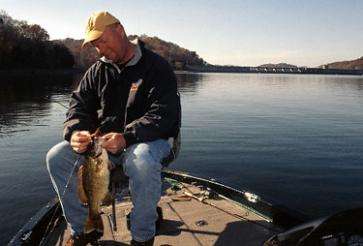
Fall is a time when lots of smallmouth anglers get away from the bottom-crawling baits that served them during the summer and opt for faster moving, horizontal lures like crankbaits and spinnerbaits.
But not me.
I have a theory, and it's one that I have a lot of confidence in. It goes like this:
Big smallmouths are lazy.
Yes, it's true that even a lazy bass will eat a crankbait from time to time … if you hit her in the mouth with it. But most of the time you're not going to be able to do that. Your casts are going to miss by a couple of feet here, a couple of inches there. It's the smaller smallmouths — typically — that will chase down these fast lures.
It takes patience and commitment, but I'll usually throw a jig when targeting big smallmouths, even in the fall.
The fish I'm after are big, slow and not inclined to chase anything. They're looking for easy meals and their instincts tell them that crawfish are good for them, likely tasty, too.
That's why I throw a jig. I love catching numbers as much as the next guy, but the fish I want and remember are the lunkers. I'd rather catch one smallie more than 5 pounds than 10 fish that weigh 2 pounds apiece.
At this time of the year, the craws are big. They've been growing and feeding all year and they're a mouthful even for a good-sized smallmouth.
I'll use a 1/4-ounce hair jig in green and orange with a Net Bait Paca Craw in green pumpkin for a trailer. It's a good-sized bait and does a better job of imitating a crawfish than a crankbait does.
I'll fish the 1/4-ounce jig down to about 30 feet. Deeper than that — or in current or wind — I'll go a little heavier. Lots of people tell me they can't feel such a light jig in such deep water. Usually that means they're not throwing it on the right gear.
I use a 7-foot, 3-inch All Pro spinning rod (the Smallmouth Guru model), but if you're not using that rod, choose a long, light and sensitive graphite model. You need the length to pick up lots of line when fishing deep water, and the sensitivity helps to detect subtle strikes.
My reel is a Shimano Stradic. It's light, has a nice big spool and a high gear ratio to crank up lots of line in a hurry.
I like Berkley Trilene 100% Fluorocarbon when fishing a jig. The fluorocarbon line is dense and sinks, which gives you a more direct connection to your jig. For most of my fall jigging, I use 8-pound test, but I'll bulk up to 10 or 12 after a rain or if the water's a little dirty.
My favorite fall pattern has me targeting pea gravel banks and black shale (slate) rock on points and in creeks. They're natural places for crawfish and smallmouth to live. If there hasn't been much rain before I'm on the water, I'll start at the mouth of the creek and expect to find smallmouths from there to about halfway back.
If there's been some recent rain, I'll start a little further back. If the water's a little more dingy than usual or even a little muddy, the bass will move shallower so you'll find them further back in the creeks.
My jig retrieve at this time of year is nothing too special. I let the jig settle to the bottom and lift my rod tip fairly slowly. As I raise the rod tip, I like to shake or pump the rod. I think that makes the jig look like a crawfish that's trying to get away. My goal is to get that jig hopping about a foot or so off the bottom and to pull it 1 or 2 feet. Of course, the strikes are almost always going to come as the bait falls.





